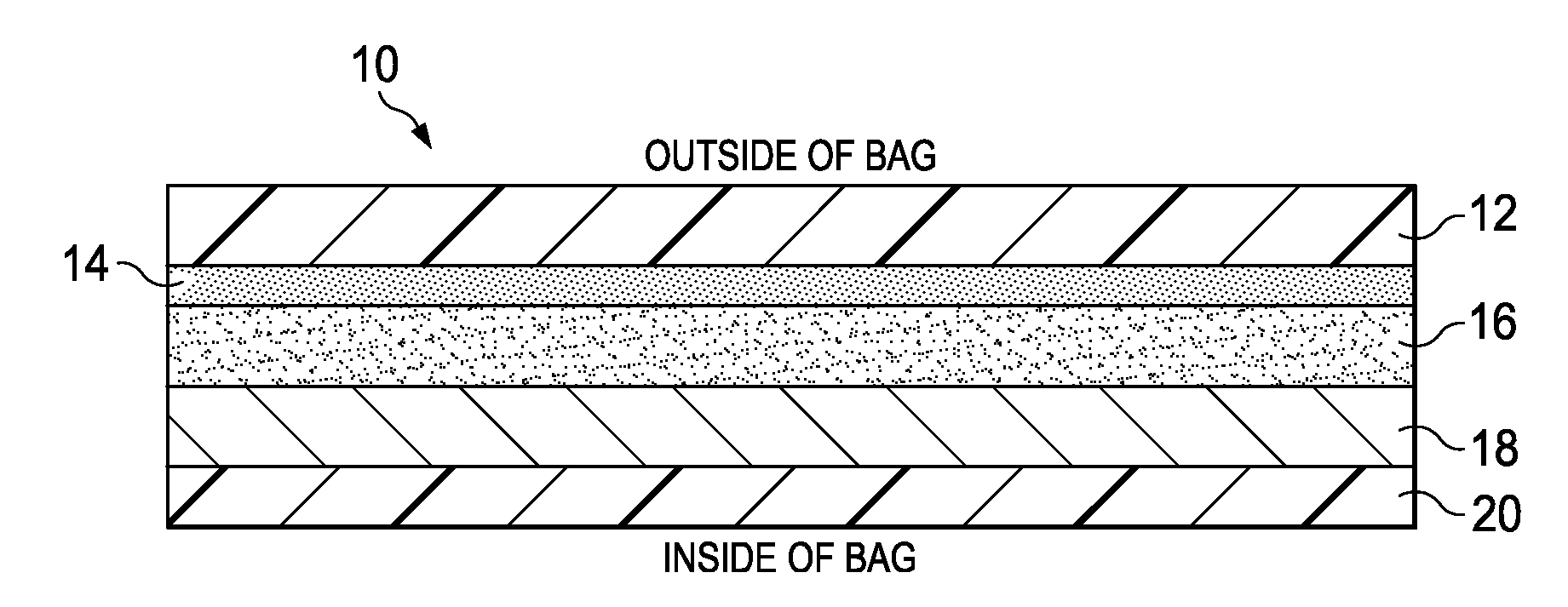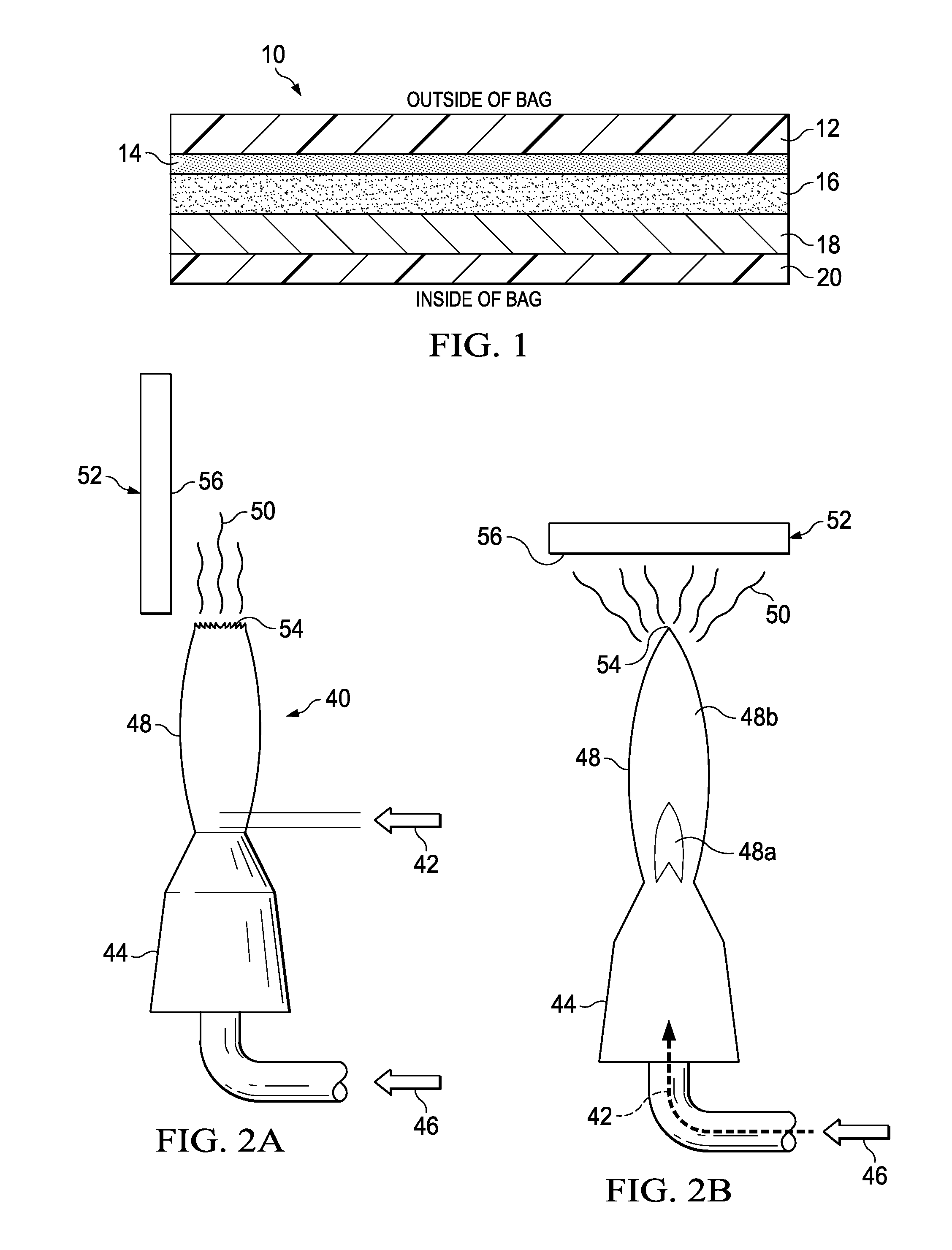Inorganic nanocoating primed organic film
- Summary
- Abstract
- Description
- Claims
- Application Information
AI Technical Summary
Benefits of technology
Problems solved by technology
Method used
Image
Examples
example 1
[0062]In-Line Flame Treatment of Oriented Polypropylene Film
[0063]In one example, polypropylene film was extruded and oriented on a film production line. The film at 70 gauge total thickness (18 μm thickness) was composed of a skin layer of Total Petrochemical 8573 polypropylene, a core of Total Petrochemical 3371 polypropylene, and an opposing skin layer of Total Petrochemical 3371 polypropylene. Flame treatment was performed on the 8573 skin layer prior to final winding of the extruded and oriented film. This film demonstrates the slight improvement in metallization performance from flame treating alone.
[0064]Flame treatment was performed with a 2-foot section of a 424-HCW-15 / 6 Ft burner from Ensign Ribbon Burner. Air for the flame was controlled by a King Instruments 7530 rotameter at about 2 cfm. An Alicat Scientific mass flow controller (model MC-10SLPM) metered methane flow for the flame. Methane for the flame was flowed at setting of 8.3 SLPM. The methane stream was mixed wit...
example 2
[0068]Online Deposition of SiO2-Based Metallization Primer on to Oriented Polypropylene Film
[0069]For comparative purposes, online flame deposition of silica (CCVD) was performed on to the 8573 skin layer of the same 8573 / 3371 / 3371 oriented polypropylene film as from Example 1 at the same 70 gauge total film thickness (18 μm thickness). The equipment was identical as described in Example 1 with the sole exception of an additional mass flow controller and bubbler that were used to introduce the silica precursor. The silica deposition and flame treatment were applied on the 8573 skin side same as Example 1. Air for the flame was delivered at 2 cfm. Two Alicat Scientific mass flow controllers, both model MC-10SLPM, metered methane flows for the flame. Primary methane for the flame was metered at 6.9 SLPM and gas entering the precursor bubbler had a methane flow setting of 1.4 SLPM. The bubbler methane gas stream flowed in to a heated bubbler containing tetraethoxysilane (TEOS, 98%, Ald...
example 3
[0073]Metallization Layer on Liquid Fuel Flame Treated PLA Polymer by Roll Coater
[0074]As an example and for comparative purposes, a biaxially oriented PLA polymer film substrate was flame treated first on the inside surface of the roll. The following typical processing conditions were used for the liquid fuel sourced flame, which atomized liquid flown through it into submicron droplets. A combustible solvent containing toluene or alcohol based solvent at a flow rate of 4 mL / min was flown through an atomizer. Next, the atomized solvent was burned into a flame in proximity of the polymer substrate. The polymer film surface was flame treated for 3 laps at a flame gas temperature at its surface of 550° C., a motion speed of 2000 inch / min, and a step size of 0.25 inch. Next, an Al metallization layer was then deposited on top of the flame treated surface by thermal evaporation. OTR was tested at 23° C. and 100% dry oxygen. An OTR of 7.18 cc / m2·day was obtained, which is a significant im...
PUM
| Property | Measurement | Unit |
|---|---|---|
| Thickness | aaaaa | aaaaa |
| Thickness | aaaaa | aaaaa |
| Acoustic impedance | aaaaa | aaaaa |
Abstract
Description
Claims
Application Information
 Login to View More
Login to View More - R&D
- Intellectual Property
- Life Sciences
- Materials
- Tech Scout
- Unparalleled Data Quality
- Higher Quality Content
- 60% Fewer Hallucinations
Browse by: Latest US Patents, China's latest patents, Technical Efficacy Thesaurus, Application Domain, Technology Topic, Popular Technical Reports.
© 2025 PatSnap. All rights reserved.Legal|Privacy policy|Modern Slavery Act Transparency Statement|Sitemap|About US| Contact US: help@patsnap.com



